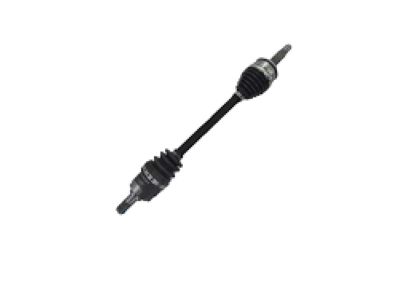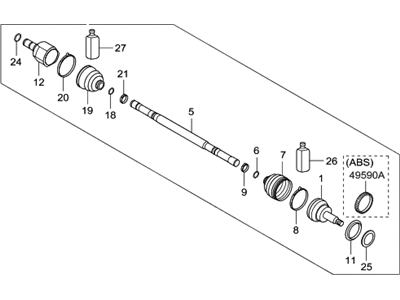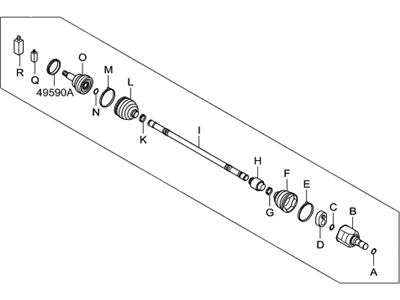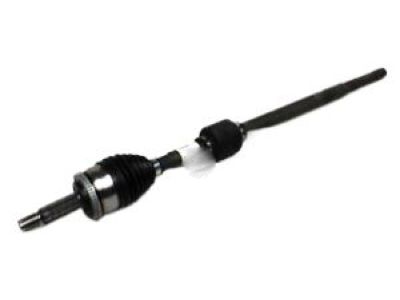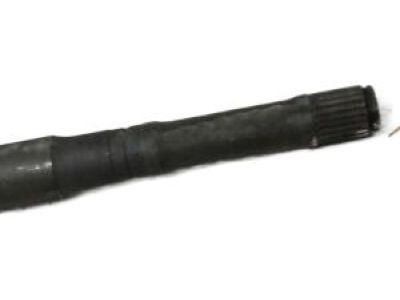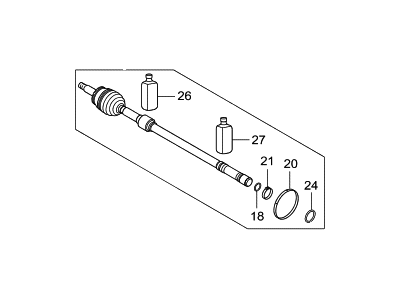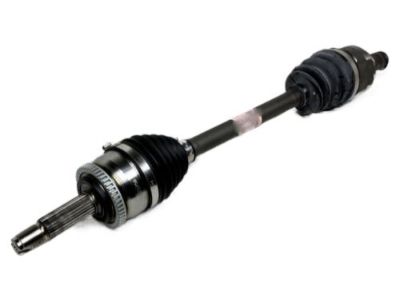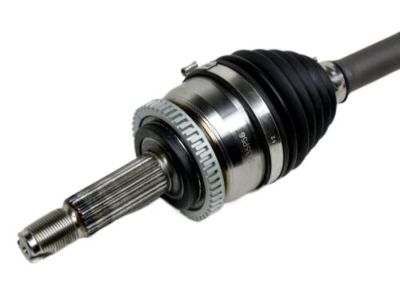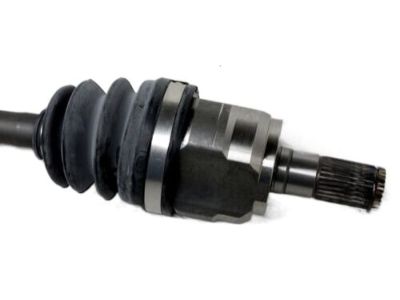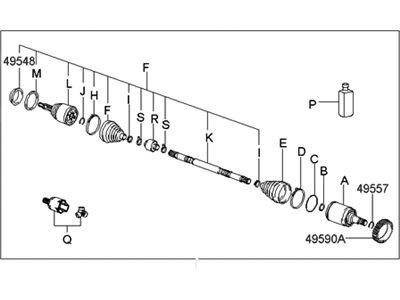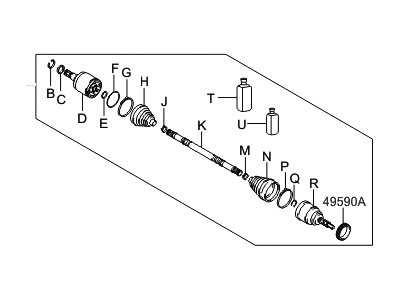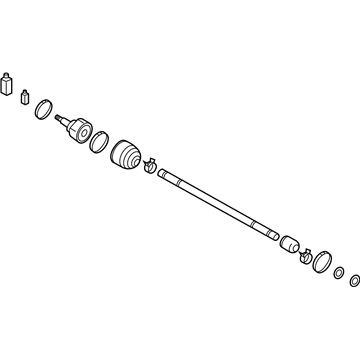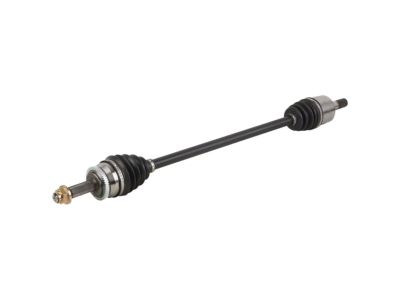×
- Hello
- Login or Register
- Quick Links
- Live Chat
- Track Order
- Parts Availability
- RMA
- Help Center
- Contact Us
- Shop for
- Hyundai Parts
- Hyundai Accessories


My Garage
My Account
Cart
Genuine Hyundai Accent Axle Shaft
Car Axle Shaft- Select Vehicle by Model
- Select Vehicle by VIN
Select Vehicle by Model
orMake
Model
Year
Select Vehicle by VIN
For the most accurate results, select vehicle by your VIN (Vehicle Identification Number).
58 Axle Shafts found

Hyundai Accent Shaft Assembly-Drive,LH
Part Number: 49500-1R000$614.24 MSRP: $870.57You Save: $256.33 (30%)Ships in 1-3 Business Days
Hyundai Accent Shaft Assembly-Drive,RH
Part Number: 49501-1R100$614.11 MSRP: $870.38You Save: $256.27 (30%)Ships in 1-3 Business Days
Hyundai Accent Joint & Shaft Kit-Front Axle W
Part Number: 49525-1R003$310.56 MSRP: $436.32You Save: $125.76 (29%)Ships in 1-3 Business Days
Hyundai Accent Shaft Assembly-Drive,LH
Part Number: 49500-1R100$515.08 MSRP: $730.03You Save: $214.95 (30%)Ships in 1-3 Business DaysHyundai Accent Shaft Assembly-Drive,LH
Part Number: 49500-25301$410.94 MSRP: $582.44You Save: $171.50 (30%)Ships in 1-3 Business DaysHyundai Accent Shaft Assembly-Drive,LH
Part Number: 49500-25300$425.33 MSRP: $602.82You Save: $177.49 (30%)Ships in 1-3 Business DaysHyundai Accent Shaft Assembly-Drive,RH
Part Number: 49500-1E151$515.08 MSRP: $730.03You Save: $214.95 (30%)Ships in 1-3 Business DaysHyundai Accent Shaft Assembly-Drive,LH
Part Number: 49500-H9300$334.79 MSRP: $470.38You Save: $135.59 (29%)Ships in 1-3 Business DaysHyundai Accent Shaft Assembly-Drive,RH
Part Number: 49500-25310$324.38 MSRP: $455.74You Save: $131.36 (29%)Ships in 1-3 Business DaysHyundai Accent Shaft Assembly-Drive,LH
Part Number: 49500-1E011$425.33 MSRP: $602.82You Save: $177.49 (30%)Ships in 1-3 Business DaysHyundai Accent Shaft Assembly-Drive,LH
Part Number: 49500-25400$425.33 MSRP: $602.82You Save: $177.49 (30%)Ships in 1-3 Business DaysHyundai Accent Shaft Assembly-Drive,LH
Part Number: 49500-1E111$432.99 MSRP: $613.68You Save: $180.69 (30%)Ships in 1-3 Business DaysHyundai Accent Shaft Assembly-Drive,LH
Part Number: 49500-1E001$324.38 MSRP: $455.74You Save: $131.36 (29%)Ships in 1-3 Business DaysHyundai Accent Shaft Assembly-Drive,RH
Part Number: 49500-25510$324.38 MSRP: $455.74You Save: $131.36 (29%)Ships in 1-3 Business DaysHyundai Accent Shaft Assembly-Drive,RH
Part Number: 49500-25511$324.38 MSRP: $455.74You Save: $131.36 (29%)Ships in 1-3 Business DaysHyundai Accent Shaft Assembly-Drive,LH
Part Number: 49500-25500$425.33 MSRP: $602.82You Save: $177.49 (30%)Ships in 1-3 Business DaysHyundai Accent Shaft Assembly-Drive,RH
Part Number: 49500-25311$432.99 MSRP: $613.68You Save: $180.69 (30%)Ships in 1-3 Business DaysHyundai Accent Joint & Shaft Kit-Front Axle W
Part Number: 49525-H9200$299.21 MSRP: $420.38You Save: $121.17 (29%)Ships in 1-3 Business DaysHyundai Accent Shaft Assembly-Drive,RH
Part Number: 49501-H9300$334.79 MSRP: $470.38You Save: $135.59 (29%)Ships in 1-3 Business Days
Hyundai Accent Shaft Assembly-Drive,RH
Part Number: 49501-1R050$618.10 MSRP: $876.05You Save: $257.95 (30%)
| Page 1 of 3 |Next >
1-20 of 58 Results
Hyundai Accent Axle Shaft
The Axle Shaft in Hyundai Accent cars or any other car model is among the vital car parts because it conveys the power from the differential to the drive wheels to achieve independent rotation for better tractions. These steel shafts are available in different forms which include; solitary axle for professionals vehicles and some elder rear wheel drive cars and halfshaft for cars with on going suspension. Diffs and axle shafts are placed in the solid axles while half shafts connect the transaxle to the wheels. They both are subjected to mechanical stresses, and they leak noises, vibrations, and in some occasions, the lubricants. Another component that directly contributes to Accent's performance is axle shafts because they bear a portion of vehicle weight, transfer drive torque to wheels, and help maintain proper wheel alignment.
If you are looking for affordable high-quality OEM Hyundai Accent Axle Shaft, then you have come to the prime place. Our website provides a large amount of genuine Hyundai Accent Axle Shaft at unbeatable prices. All our parts come backed with the manufacturer's warranty.
Hyundai Accent Axle Shaft Parts Questions & Experts Answers
- Q: What information is provided about the Axle Shaft and power transmission in a Hyundai Accent?A:Power is transmitted from the transaxle to the wheels through a pair of axle shafts. The inner end of each axle shaft is splined to the differential. The outer ends of the axle shafts are splined to the axle hubs and locked in place by an axle nut. The inner ends of the axle shafts are equipped with sliding double offset joints (1994 and earlier) or tri-pot joints (1995 and later), which are capable of both angular and axial motion. Each inner joint assembly consists of an inner race, ball bearing and cage assembly (double offset joint) or a tri-pot spider bearing assembly (1995 and later models) and an outer race (housing) in which the inner bearing assembly is free to slide in and out as the axle shaft moves up and down with the wheel. The inner joints are replaceable. Each outer joint, which consists of ball bearings running between an inner race and an outer cage, is capable of angular but not axial movement. The outer joints are neither rebuildable nor removable. Should one of them fail, a new axle shaft/outer joint assembly must be installed. The boots should be periodically inspected for damage, leaking lubricant and cuts. Damaged CV Joint Boots must be replaced immediately or the joints can be damaged. Boot replacement involves removal of the axle shaft. Note: Some auto parts stores carry "split" type replacement boots, which can be installed without removing the axle shaft from the vehicle. This is a convenient alternative; however, it's recommended that the axle shaft be removed and the CV joint disassembled and cleaned to ensure that the joint is free from contaminants such as moisture and dirt, which will accelerate CV joint wear. The most common symptom of worn or damaged CV joints, besides lubricant leaks, is a clicking noise in tums, a clunk when accelerating from a coasting condition or vibration at highway speeds. To check for wear in the CV joints and axle shafts, grasp each axle (one at a time) and rotate it in both directions while holding the CV joint housings, inspecting for movement, indicating worn or damaged CV joints. Also check the axle shafts for cracks, dents, twisting and bending.
Related Hyundai Accent Parts
Browse by Year
2022 Axle Shaft 2021 Axle Shaft 2020 Axle Shaft 2019 Axle Shaft 2018 Axle Shaft 2017 Axle Shaft 2016 Axle Shaft 2015 Axle Shaft 2014 Axle Shaft 2013 Axle Shaft 2012 Axle Shaft 2011 Axle Shaft 2010 Axle Shaft 2009 Axle Shaft 2008 Axle Shaft 2007 Axle Shaft 2006 Axle Shaft 2005 Axle Shaft 2004 Axle Shaft 2003 Axle Shaft 2002 Axle Shaft 2001 Axle Shaft 2000 Axle Shaft 1999 Axle Shaft 1998 Axle Shaft 1997 Axle Shaft 1996 Axle Shaft 1995 Axle Shaft 1994 Axle Shaft
